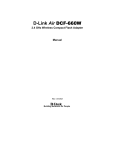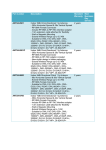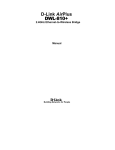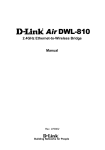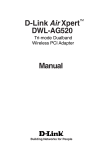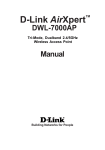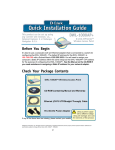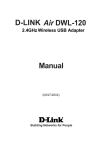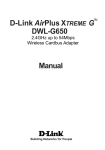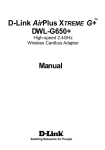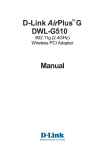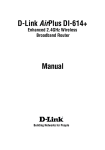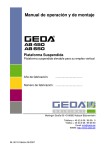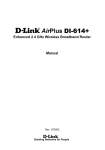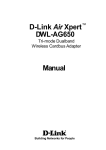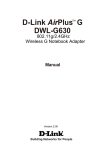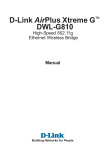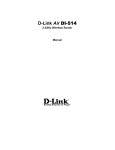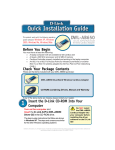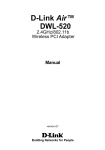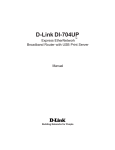Download D-Link DWL-1000AP+ Installation guide
Transcript
D-Link AirPremier DWL-1000AP+ Enterprise 2.4GHz Wireless Access Point Manual Building Networks for People Contents Package Contents ................................................................................ 3 Introduction ........................................................................................... 4 LEDs ..................................................................................................... 6 Wireless Basics .................................................................................... 7 Getting Started ....................................................................................11 Using the Configuration Menu ............................................................ 12 Troubleshooting .................................................................................. 26 Technical Specifications ..................................................................... 35 Contacting Technical Support ............................................................. 37 Warranty and Registration .................................................................. 38 2 Package Contents Contents of Package: D-Link AirPremier DWL-1000AP+ Enterprise 2.4 GHz Wireless Access Point Manual and Warranty on CD Quick Installation Guide Power Supply - 5V DC, 2.0A Ethernet Cable (DWL-1000AP+ Ethernet port is Auto-MDIX) Note: Using a power supply with a different voltage rating than the one included with the DWL-1000AP+ will cause damage and void the warranty for this product. If any of the above items are missing, please contact your reseller. System Requirements for Configuration: A computer with Windows, Macintosh, or Linux-based operating system with an installed Ethernet adapter Internet Explorer or Netscape Navigator version 6.0 or above, with JavaScript enabled 3 Introduction The D-Link AirPremier DWL-1000AP+ Wireless Access Point is an 802.1x high-performance wireless access point. With a second level of security that is not offered with other conventional 802.11 standards-compatible Access Points, the DWL-1000AP+ ensures a more secure wireless network than ever before. In addition to WEP encryption, the DWL-1000AP+ offers an Authentication capability when used with 802.1x compatible devices. This extra layer of protection will ensure a safer and more secure wireless network than has previously been available. Outstanding features of the DWL-1000AP+ include Backup AP Function, Load-Balancing, and Dynamic Channel Selection Function. Please see the Features and Benefits section in this manual for further details on these special features. Speed is another unique feature of the DWL-1000AP+. Unlike most access points, the DWL-1000AP+ is capable of data transfer speeds of up to 22 Mbps* (compared to the standard 11 Mbps) when used with D-Link AirPlus products such as the DWL-520+ Wireless PCI Adapter and DWL-650+ Wireless Cardbus Adapter. After completing the steps outlined in the Quick Installation Guide (included in your package) you will have the ability to share information and resources, such as files and printers, and enjoy the freedom that wireless networking delivers. The DWL-1000AP+ is compatible with most popular operating systems, including Macintosh, Linux and Windows, and in conjunction with a radius server, can be integrated into a large enterprise network. This Manual is designed to help you connect the Access Point and D-Link Adapters into a network in Infrastructure mode. Please take a look at the Getting Started section in this manual to see an example of an Infrastructure network using the DWL-1000AP+. This manual provides a quick introduction to wireless technology and its application as it relates to networking. *Maximum wireless signal rate derived from IEEE Standard 802.11b specifications. Actual data throughput will vary Network conditions and environmental factors, including volume of network traffic, building materials and construction, and network overhead lower actual data throughput rate. 4 Features and Benefits Supports 802.1x for wireless user authentication into the network, resulting in a more secure wireless network than was previously possible. Backup AP Function ensures continued operation of the AP in the event of any operation failure of the primary AP Load Balancing Function allows for automatic connection by the client to the AP with the least traffic and the least number of clients, when several APs are deployed in one wireless network 5 operating modes available: Access Point, AP Client and Bridge (Point-toPoint; Point-to-Multi-point), Wireless Client; Wireless Repeater Dynamic data rate scaling at 1, 2, 5.5,11Mbps and 22Mbps Supports wireless data encryption with 64-bit, 128-bit WEP security (and 256-bit WEP security with D-Link AirPlus Adapters.) Two detachable antennas for diversity functionality as well as adjustable transmit power to adjust the wireless range DHCP server capability Dynamic Channel Selection Function automatically selects the fastest and least populated channel available for the DWL-1000AP+ when it is a part of a Load Balancing Group of 4 or more Access Points, where the 3 non-overlapping channels have already been selected. 802.1x Authentication requires EAP (Extensible Authentication Protocol). 802.1x supported EAP is available through the Windows XP Operating System. You will need to use the same type of EAP protocol on all the devices in your network when using the 802.1x feature. 5 LEDs After the initial post sequence, upon startup, the LEDs will read as follows: Diagnostic A solid green light indicates that the unit is defective. Power/Status A solid green light indicates a proper connection to the power supply. Local Network A solid green light indicates an Ethernet connection on ports 1-2. This LED blinks during data transmission. WLAN (Wireless Local Area Network)A solid green light indicates that the wireless segment is ready. This LED blinks during wireless data transmission. 6 Wireless Basics D-Link wireless products are based on industry standards to provide easy-to-use and compatible high-speed wireless connectivity within your home, business or public access wireless networks. Strictly adhering to the IEEE standard, the D-Link wireless family of products will allow you to securely access the data you want, when and where you want it. You will be able to enjoy the freedom that wireless networking delivers. A wireless local area network (WLAN) is a cellular computer network that transmits and receives data with radio signals instead of wires. Wireless LANs are used increasingly in both home and office environments, and public areas such as airports, coffee shops and universities. Innovative waysto utilize WLAN technology are helping people to work and communicate more efficiently. Increased mobility and the absence of cabling and other fixed infrastructure have proven to be beneficial for many users. Wireless users can use the same applications they use on a wired network. Wireless adapter cards used on laptop and desktop systems support the same protocols as Ethernet adapter cards. Under many circumstances, it may be desirable for mobile network devices to link to a conventional Ethernet LAN in order to use servers, printers or an Internet connection supplied through the wired LAN. A Wireless Router is a device used to provide this link. 7 Wireless Basics (continued) People use wireless LAN technology for many different purposes: Mobility - Productivity increases when people have access to data in any location within the operating range of the WLAN. Management decisions based on real-time information can significantly improve worker efficiency. Low Implementation Costs – WLANs (Wireless Local Area Networks) are easy to set up, manage, change and relocate. Networks that frequently change, both physically and logically, can benefit from WLANs ease of implementation. WLANs can operate in locations where installation of wiring may be impractical. Installation Speed and Simplicity - Installing a wireless LAN system can be fast and easy and can eliminate the need to pull cable through walls and ceilings. Network Expansion - Wireless technology allows the network to go where wires cannot. Scalability – Wireless Local Area Networks (WLANs) can be configured in a variety of topologies to meet the needs of specific applications or existing infrastructures. Configurations are easily changed and range from peer-to-peer networks suitable for a small number of users to larger infrastructure networks to accommodate hundreds or thousands of users, depending on the number of wireless devices deployed. 8 Wireless Basics (continued) The DWL-1000AP+ is compatible with the following D-Link AirPro dual-band wireless network adapters: 2.4GHz multimode Wireless Cardbus Adapter used with laptop computers (DWL-AB650) 2.4GHz Wireless PCI card used with desktop computers AB520) (DWL- The DWL-1000AP+ is also compatible with the following D-Link AirPlus wireless network adapters: 2.4GHz Wireless PCI card used with desktop computers (DWL-520+) 2.4GHz Wireless Cardbus Adapter used with laptop computers (DWL-650+) Standards-Based Technology The versatile DWL-1000AP+ Wireless Access Point is 802.1x compatible. The 802.1x standard solves the problem of ensuring the safety of wireless networks by allowing for an additional layer of security. With two levels of security, Authentication and Data Encryption, the 802.1x enhanced wireless network is more inaccessible to intruders than has previously been possible. The Authentication protocol in 802.1x provides the frontline of defense against network intrusion. EAP (Extensible Authentication Protocol) is the protocol used for authentication. Windows XP currently supports EAP. All the clients, access points, and servers must share the same type of EAP in order to communicate and ensure that the network is secure. You can also purchase EAP software to install 802.1x support for the wireless clients in your network. The second level of security for the wireless network is WEP data encryption. Depending on the radius server deployed in your network, you can distribute the certificate automatically and change Encryption keys in the wireless network. This network feature will greatly reduce the amount of time needed to ensure wireless security by automatically changing WEP keys periodically, thus relieving administrators of the onerous task of manually changing keys on a multitude of workstations. 9 Wireless Basics (continued) Installation Considerations Keep in mind that the number, thickness and location of walls, ceilings, or other objects that the wireless signals must pass through, may limit the range. Typical ranges vary depending on the types of materials and background RF (radio frequency) noise in your home or business. The key to maximizing wireless range is to follow these basic guidelines: 1. Keep the number of walls and ceilings between the DWL-1000AP+ and other network devices to a minimum - each wall or ceiling can reduce your D-Link Wireless product’s range from 3-90 feet (1-30 meters.) Position your devices so that the number of walls or ceilings is minimized. 2. Be aware of the direct line between network devices. A wall that is 1.5 feet thick (.5 meters), at a 45-degree angle appears to be almost 3 feet (1 meter) thick. At a 2-degree angle it looks over 42 feet (14 meters) thick! Try to make sure that devices are positioned so that the signal will travel straight through a wall or ceiling for better reception. 3. Building Materials make a difference - a solid metal door or aluminum studs may have a negative effect on range. Try to position wireless devices and computers with wireless adapters so that the signal passes through drywall or open doorways and not other materials. 4. Keep your product away (at least 3-6 feet or 1-2 meters) from electrical devices or appliances that generate RF noise. 10 Getting Started Here is a sample of a network setup using the 802.1x compliant DWL-1000AP+ access point. Your network may look different. For successful communication, you will need 802.1x compliant devices, including 802.1x compliant wireless network adapters. If you are using two or more access points in conjunction for load-balancing or backup, please remember that IAPP (Inter Access Point Protocol) is passed through the Ethernet connection. Please read through the configuration section of this manual to learn about the settings you will need for your devices to achieve a faster, safer and more effective wireless network than you have previously experienced. 11 Using the Configuration Menu There are several methods of managing your network with the DWL-1000AP+. You can use the web-based configuration that is illustrated in this section. To access the configuration menu, input the IP Address (192.168.0.50) of the DWL-1000AP+ into the address field in your web browser. Or if you have a network with a group of Access Points, you can use the AP Manager to configure the Access Points. Lastly, you can use SNMP to manage your network. If you choose to use the web-based configuration menu, please configure the DWL1000AP+ from a computer with an ethernet connection to the DWL-1000AP+. Home > Wizard Clicking Apply will save changes made to the page Apply Clicking Cancel will clear changes made to the page Cancel Clicking Help will bring up helpful information regarding the page Help Clicking Restart will restart the router. (Necessary for some changRestart 12 Using the Configuration Menu Home > Wireless AP Name: You may choose to rename your Access Point, especially if you have more than one Access Point on your network. SSID: (Service Set Identifier) default is the default setting. The SSID is a unique name that identifies a network. All devices on a network must share the same SSID name in order to communicate on the network. If you choose to change the SSID from the default setting, input your new SSID name in this field. The SSID can be up to 32 characters in length. Channel: Channel 6 is the default channel. Input a new number if you want to change the default setting. All devices on the network must be set to the same channel to communicate on the network. (However, if are employing the Load Balancing function of the AP, you will need to set each AP to a different non-overlapping channel: 1, 6 or 11. Clients in a “load balancing” network should set their channel to “auto.”) Dynamic Channel Selection Function: automatically selects the fastest and least populated channel available for the DWL-1000AP+ when it is a part of a Load Balancing Group of 4 or more Access Points, when the 3 non-overlapping channels have already been selected. WEP Encryption: Select Enable Encryption to use WEP (Wired Equivalent Privacy) on the network. All devices on the network, and the Access Point, must share the same WEP selection – either Enable or Disable, and they must share the same WEP key. The WEP key is generated from ASCII or Hexadecimal entries that are either 64, 128, or 256 bit in length. When enabling encryption, select the Key Type (ASCII or Hexadecimal) and then input the appropriate digits or letters. You can create up to 4 keys. Select the key you wish to use. Hexadecimal digits consist of the numbers 0-9 and the letters A-F ASCII (American Standard Code for Information Interchange) is a code for representing English letters as numbers from 0-127 13 Using the Configuration Menu Home > LAN Dynamic IP Address: Select this option if you would like to have an IP Address automatically assigned to the DWL-1000AP+ by a DHCP server in your network. DHCP stands for Dynamic Host Configuration Protocol. It is a protocol for assigning dynamic IP addresses “automatically.” With a DHCP Server there is no need to manually assign an IP address. Static IP Address: Select this option if you are manually assigning an IP Address. IP Address: 192.168.0.50 is the default IP Address of the Access Point. If you are using several DWL-1000AP+’s in your network (for Load Balancing or Backup), you will need to assign a different Static IP Address to each Access Point. Subnet Mask: 255.255.255.0 is the default Subnet Mask. All devices on the network must have the same subnet mask to communicate on the network Gateway: Enter the IP Address of the gateway in your network IP Address If you need to assign Static IP Addresses to the devices in your network, please remember that the IP Address for each computer or device must be in the same IP Address range as all the devices in the network. Each device must also have the same Subnet Mask. For example: Assign the first computer an IP Address of 192.168.0.2 and a Subnet Mask of 255.255.255.0, the second device an IP Address of 192.168.0.3 and a Subnet Mask of 255.255.255.0, and so on. Devices that are assigned the same IP Address may not be visible on the network. 14 Using the Configuration Menu Home > DHCP DHCP Server: Select Enabled or Disabled. Disabled is the default setting. If you want to use the Access Point as a DHCP server to automatically assign Dynamic IP Addresses on the network, you will select Enabled. Starting IP Address: If you have enabled the DHCP server function, enter the starting point of the IP Address range for your network Ending IP Address: Enter the ending IP Address of your IP Address range, if you have enabled the DHCP function of the Access Point Lease Time: Choose the length of time at which the DHCP function of the DWL- 1000AP+ automatically regenerates the IP Addresses to the devices in your network DHCP Client Table: Lists the devices on your network that are receiving dynamic IP Addresses from the Access Point 15 Using the Configuration Menu Advanced > Mode Access Point: The Access Point is selected as the default setting. This must be selected to use Load Balancing Mode and Backup Mode. Load Balancing: Allow several DWL-1000AP+’s with the same group name to share the wireless network traffic. We recommend an optimal number of three DWL-1000AP+’s in close proximity because there are 3 non-overlapping channels (as specified by the 802.11b standard.) After selecting this option, you will be prompted to enter a Group Name. All the APs that share Load Balancing must have the same Group Name and the same SSID. Assign each Access Point a different non-overlapping channel (e.g., 1, 6, 11). Backup AP: Connect 2 DWL-1000AP+s with an Ethernet cable. One of the APs will be the Primary AP, the other AP will backup the primary AP in the event of a primary AP failure. Enter the Primary AP’s MAC Address into the secondary AP’s configuration window. To use the Keep Alive Connection, enter the IP address of a radius server or router on your network. The Keep Alive Connection will monitor the connection to the Ethernet network and send a notification to the administrator of any connectivity problems with the LAN (Local Area Network) connection. Wireless Client: Make this selection to use the DWL-1000AP+ as a wireless client instead of as an Access Point; you will enter the MAC address of the remote AP to which the DWL-1000AP+ will be a client. Site Survey: Click Site Survey to see available APs on the wireless network and their MAC addresses when the DWL-1000AP+ is in client mode. Wireless Bridge: To use the DWL-1000AP+ as a wireless bridge you will enter the MAC address of the remote bridge to which the AP will associate. Multi-point Bridge: Select this option to use the DWL-1000AP+ as a mult-point bridge. In this mode it will associate with remote bridges. Repeater: To extend the range of the wireless network select this option and enter the MAC address of the remote AP within your network that will have its range extended. Please note that the DWL-1000AP+ is able to repeat the wireless signal from another DWL-1000AP+, DWL-900AP+, DI-614+, DI-764, and DI-754 with a DWL-650+. 16 Using the Configuration Menu Advanced > Performance The default Performance settings are shown here. Beacon Interval: Beacons are packets sent by an Access Point to synchronize a wireless network. Specify a Beacon interval value. Default (100) is recommended. RTS Threshold: This value should remain at its default setting of 2,432. If you encounter inconsistent data flow, only minor modifications to the value range between 256 and 2,432 are recommended. Fragmentation: This value should remain at its default setting of 2,346. If you experience a high packet error rate, you may slightly increase your Fragmentation Threshold within the value range of 256 to 2,346. Setting the Fragmentation Threshold too low may result in poor performance. DTIM Interval (Beacon Rate): (Delivery Traffic Indication Message) Enter a value between 1 and 255 (default is 3) for the Delivery Traffic Indication Message (DTIM.) A DTIM is a countdown informing clients of the next window for listening to broadcast and multicast messages. Basic Rates: Default is 1-2Mbps. We recommend that you keep the setting at default. If you lose connection at the TX rate, you will regain connection at the basic rate. A lower Basic Rate will make reconnection easier. (If you are running a wireless network consisting of all D-Link AirPlus and Air Premier products, you may set a higher basic rate.) TX Rates: Select the transmission rate for the network. The default rate is 1-2-5.5-11-22Mbps. Preamble: Long Preamble is the default setting. (High traffic networks should use the shorter preamble type.) The preamble defines the length of the CRC block (Cyclic Redundancy Check is a common technique for detecting data transmission errors) used in communication between the Access Point and the roaming wireless Network adapters. Authentication: Open System - communicates the key across the network Shared Key - devices must have identical WEP settings to communicate Auto - automatically adjusts to the Authentication mode of the wireless client 17 SSID Broadcast: (Service Set Identifier) Enable or Disable (default) the broadcast of the SSID name across the network. SSID is a name that identifies a wireless network. All devices on a network must use the same SSID to establish communication. Client Security: Disabled is the default setting. Enabling this setting ensures that the wireless clients will be secure and their files and folders will not be available to other wireless clients Antenna selection: Choose Left, Right or Diversity. Diversity is the default selection. By choosing which antenna is active, you can more selectively configure your network. Antenna transmit power: Default is the default setting. Select the range you desire for your AP transmission. If you do not want the signal to range too far, you can limit the distance with this tool. This may be helpful in securing your network. Using the Configuration Menu Advanced> Filters Use MAC Filters to allow or deny computers by their MAC addresses from accessing the DWL-1000AP+. You can either manually add a MAC address or select the MAC address from the list of clients that are currently connected to the Broadband Router. The default setting is Disabled MAC Filters. MAC Filter List: This list will display the MAC addresses that are in the selected filter 18 Using the Configuration Menu Advanced > 802.1x Disabled is the default selection for 802.1x protocol. Select Enabled to enable it. Encryption Key: Select the key length, either 64 bits or 128 bits. Lifetime: Select 5, 15, 30 minutes, or 1or 8 hours, or 1 day for the authentication period. After this period expires, a new key will automatically be generated. Radius Server 1 IP: Enter the IP Address of the Radius Server Port: Enter the port number that your Radius Server uses for Authentication. Radius Servers The default setting of 1812 is the port setting for many Shared Secret: Enter the Shared Secret. The shared secret must be the same as the shared secret on your radius server. Radius Server 2: Optional. If you have a second radius server, you will input the same information as shown above. 19 Using the Configuration Menu Tools > Admin SNMP (Simple Network Management Protocol) is a widely used network monitoring and control protocol. The DWL-1000AP+ supports SNMP V1. SNMP allows one computer on the network (the administrator) to monitor the devices on the network and to perform management functions. New Password: Enter the new password Confirm Password: Re-enter the password to confirm it Enabled is the default selection. Select Disabled to disable it. System Location: enter a name for information only (e.g., “Accounting”) System Contact: enter a name for information only (e.g., “John”) Community: If you enter a community “name” here, you must enter the same “name” on the SNMP tool before you can use the management functions Trap Receiver: 1: enter IP address of the computer that will receive trouble alerts 2: enter IP address of the computer that will receive trouble alerts 3:enter IP address of the computer that will receive trouble alerts 20 Using the Configuration Menu Tools > System Save Settings: The current system settings can be saved as a file onto the local hard drive. Load Settings: The saved file or any other saved setting file can be loaded back on the Access Point. To reload a system settings file, click on Browse to browse the local hard drive and locate the system file to be used. Click Load when you have selected the file to be loaded back onto the Access Point. Restore: You may also reset the Access Point back to factory settings by clicking on Restore. Make sure to save the unit’s settings before clicking on Restore. 21 Using the Configuration Menu Tools > Firmware Firmware Upgrade You can upgrade the firmware of the Access Point at this page. Make sure the firmware you want to use is on the local hard drive of the computer. Click on Browse to browse the local hard drive and locate the firmware to be used for the update. Please check the D-Link support site for firmware updates at http://support.dlink.com. Once you have found the firmware to be used, click Apply. Status > Device Info This screen displays the current settings of the DWL-1000AP+. 22 Using the Configuration Menu Status > Log View Log The Access Point keeps a running log of events and activities occurring on the AP. If the device is rebooted, the logs are automatically cleared. You may save the log files under Log Setting. First Page - The first page of the log. Last Page - The last page of the log. Previous - Moves back one log page. Next - Moves forward one log page. Clear - Clears the logs completely. Log Settings - Brings up the page to configure the logs. Log Settings Not only does the Access Point display the logs of activities and events, it can be setup to send these logs to another location. The logs can be sent via email to an email account. SMTP Server - The address of the SMTP server that will be used to send the logs. Send to - The email address the logs will be sent to. Click on Email Log Now to send the email. 23 Using the Configuration Menu Status> Stats Traffic Statistics The Access Point keeps statistics of traffic that passes through it. You are able to view the amount of packets that passes through the Router on both the Ethernet portion of the network and the Wireless portion of the network. The traffic counter will reset if the device is rebooted. Status > Wireless Connected Wireless PCs LIst This list displays the MAC Addresses of connected PC’s and the length of time that they have been connected. 24 Using the Configuration Menu Help Select from the menu above for extra help. 25 Troubleshooting This chapter provides solutions to problems that can occur during the installation and operation of the DWL-1000AP+. We cover various aspects of the network including network adapters. (The examples below are illustrated in Windows XP. If you have another operating system, these solutions will still apply although the appearance on your computer screen may differ.) Note: It is recommended that you use an Ethernet connection to configure the DWL-1000AP+ Access Point. 1. The computer used to configure the DWL-1000AP+ cannot access the Configuration menu. Check that the Ethernet LED on the DWL-1000AP+ is ON. If the LED is not ON, check that the cable for the Ethernet connection is securely inserted. Check that the Ethernet Adapter is working properly. Please see item 3 (Check that the drivers for the network adapters are installed properly) in this Troubleshooting section to check that the drivers are loaded properly. Check that the IP Address is in the same range and subnet as the DWL-1000AP+. Please see Checking the IP Address in Windows XP in the Networking Basics section of this Note: The IPmanual. Address of the DWL-1000AP+ is 192.168.0.50. All the computers on the network must have a unique IP Address in the same range, e.g., 192.168.0.x. Any computers that have identical IP Addresses will not be visible on the network. They must all have the same subnet mask, e.g., 255.255.255.0 Do a Ping test to make sure that the DWL-1000AP+ is responding. Go to Start>Run>Type Command>Type ping 192.168.0.50. A successful ping will show four replies. 26 Troubleshooting (continued) 2. The wireless client cannot access the Internet in the Infrastructure mode. Make sure the wireless client is associated and joined with the correct Access Point. To check this connection: Right-click on the Local Area Connection icon in the taskbar> select View Available Wireless Networks. The Connect to Wireless Network screen will appear. Please make sure you have selected the correct available network, as shown in the illustrations below. Check that the IP Address assigned to the wireless adapter is within the same IP Address range as the access point and gateway. Since the DWL-1000AP+ has an IP Address of 192.168.0.50, wireless adapters must have an IP Address in the same range, e.g., 192.168.0.x. Each device must have a unique IP Address; no two devices may have the same IP Address. The subnet mask must be the same for all the computers on the network.) To check the IP Address assigned to the wireless adapter, double-click on the Local Area Connection icon in the taskbar > select the Support tab and the IP Address will be displayed. (Please refer to Checking the IP Address in the Networking Basics section of this manual.) If it is necessary to assign a Static IP Address to the wireless adapter, please refer to the instructions on the following page. 27 Troubleshooting (continued) Assigning a Static IP Address in Windows XP/2000 Note: Residential Gateways/Broadband Routers will automatically assign IP Addresses to the computers on the network, using DHCP (Dynamic Host Configuration Protocol) technology. If you are using a DHCP-capable Gateway/Router you will not need to assign Static IP Addresses. If you are not using a DHCP capable Gateway/Router, or you need to assign a Static IP Address, please follow these instructions: Go to Start Double-click on Control Panel Double-click on Network Connections 28 Troubleshooting (continued) Assigning a Static IP Address in Windows XP/2000 Right-click on Local Area Connections Double-click on Properties Assigning a Static IP Address in Windows XP/2000 Click on Internet Protocol (TCP/IP) Click Properties 29 Troubleshooting (continued) Assigning a Static IP Address in Windows XP/2000 In the window below, select Use the following IP address. Input your IP address and subnet mask. (The IP Addresses on your network must be within the same range. For example, if one computer has an IP Address of 192.168.0.2, the other computers should have IP Addresses that are sequential, like 192.168.0.3 and 192.168.0.4. The subnet mask must be the same for all the computers on the network.) IP Address: e.g., 192.168.0.2 Subnet Mask: 255.255.255.0 Default Gateway: Enter the IP address of the gateway. Select Use the following DNS server address. Enter the IP address of the DNS Server. Click OK You have completed the assignment of a Static IP Address. (You do not need to assign a Static IP Address if you have a DHCP Server.) 30 Troubleshooting (continued) 3. Check that the drivers for the network adapters are installed properly. You may be using different network adapters than those illustrated here, but this procedure will remain the same, regardless of the type of network adapters you are using. Go to Start > Right-click on My Computer > Click Properties Select the Hardware Tab Click Device Manager 31 Troubleshooting (continued) Double-click on Network Adapters Right-click on D-Link DFE-530TX+ Ethernet PCI Adapter Select Properties to check that the drivers are installed properly Look under Device Status to check that the device is working properly D-Link DFE-530TX+ Ethernet PCI Adapter D-Link Ethernet DFE-530TX+ PCI Adapter Click OK 32 Troubleshooting (continued) 4. What variables may cause my wireless products to lose reception? D-Link products let you access your network from virtually anywhere you want. However, the positioning of the products within your environment will affect the wireless range. Please refer to Installation Considerations in the Wireless Basics section of this manual for further information about the most advantageous placement of your D-Link wireless products. 5. Why does my wireless connection keep dropping? Antenna Orientation- Try different antenna orientations for the DWL1000AP+. Try to keep the antenna at least 6 inches away from the wall or other objects. If you are using 2.4GHz cordless phones, X-10 equipment or other home security systems, ceiling fans, and lights, your wireless connection will degrade dramatically or drop altogether. Try changing the Channel on your Router, Access Point and Wireless adapter to a different Channel to avoid interference. Keep your product away (at least 3-6 feet) from electrical devices that generate RF noise, like microwaves, Monitors, electric motors, etc. 6. Why can’t I get a wireless connection? If you have enabled Encryption on the DWL-1000AP+, you must also enable encryption on all wireless devices in the network in order to establish a wireless connection. The Encryption settings are: 64, 128, or 256 bit. Make sure that the encryption bit level is the same on the DWL-1000AP+ and all the devices on the network. Make sure that the SSID on the Router, the DWL-1000AP+ and all the devices on the network are exactly the same. If they are not, wireless connection will not be established. Check that the correct EAP type for 802.1x authentication is selected for the wireless client. If using certification, check that the correct certification is properly installed. 33 Troubleshooting (continued) 7. Why is load balancing not working properly within a group of access points? Check that the access points are connected through the ethernet cable. Please keep in mind that the IAPP (Inter Access Point Protocol) is passed only through the ethernet connection. Check that the same Group Name is specified in the setting for each access point. 8. Why doesn’t the back-up access point take over for the primary access point when the primary access point is not functioning? Check that both the primary and the backup access point are connected to each other as well as the ethernet backbone. (Also, please remember that IAPP-Inter Access Point Protocol-will not function unless the access points are connected with an ethernet cable.) Check that the backup access point is configured with the correct Ethernet MAC address of the primary access point. Check that the correct EAP type for 802.1x authentication is selected for the wireless client. If using certification, check that the correct certification is properly installed. 34 Technical Specifications Standards IEEE 802.3 IEEE 802.3u IEEE 802.11b IEEE 802.1x Diagnostic LED Power Diagnostic WLAN (Wireless Local Area Network) (2) Local Network (Ethernet) Temperature Operating: 0ºC to 55ºC (32ºF to 131ºF) Storing: -20ºC to 75ºC (-4ºF to 167ºF) Humidity: 95% maximum, non-condensing External Antenna Type: 2.0dB gain with reverse SMA connector Power Input: External Power Supply: DC5V, 2.0A Device Management: Web-based: Internet Explorer v. 6 or later; Netscape Navigator v 6x or later; or other Java-enabled browsers. Safety & Emissions: FCC UL Physical Dimensions: L = 9.25 inches (233 mm) W = 6.5 inches (165 mm) H = 1.38 inches (35 mm) Port: (2) 10/100 Mbps Fast Ethernet (Auto-MDIX) 35 Technical Specifications Data Rates:* (with Automatic Fallback) 1, 2, 5.5, 11Mbps (22Mbps in proprietary Turbo mode) Encryption: Supports 64-bit, 128-bit or 256-bit WEP encryption (RC4) Frequency Range: 2.4 – 2.4835 GHz Modulation Techniques: Barker (1Mbps/0db) Barker (2Mbps/3db) CCK (5.5Mbps/5.5db) PBCC (5.5Mbps/8.5db) CCK (11Mbps/8.5db) PBCC (11Mbps/4.5db) PBCC (22Mbps/8.5db) Modulation Technology: PBCC - Packet Binary Convolutional Coding Direct Sequence Spread Spectrum (DSSS) 11-chip Barker sequence Transmitter Output Power: 15dBm +- 2dB Weight: 2.0 lbs. (907g) *Maximum wireless signal rate derived from IEEE Standard 802.11b specifications. Actual data throughput will vary Network conditions and environmental factors, including volume of network traffic, building materials and construction, and network overhead lower actual data throughput rate. 36 Contacting Technical Support You can find the most recent software and user documentation on the D-Link website. D-Link provides free technical support for customers within the United States for the duration of the warranty period on this product. U.S. customers can contact D-Link technical support through our web site, or by phone. D-Link Technical Support over the Telephone: (877) 453-5465 24 hours a day, seven days a week. D-Link Technical Support over the Internet: http://support.dlink.com When contacting technical support, please provide the following information: Serial number of the unit Model number or product name Software type and version number 37 Warranty and Registration Subject to the terms and conditions set forth herein, D-Link Systems, Inc. (“D-Link”) provides this Limited warranty for its product only to the person or entity that originally purchased the product from: D-Link or its authorized reseller or distributor and Products purchased and delivered within the fifty states of the United States, the District of Columbia, U.S. Possessions or Protectorates, U.S. Military Installations, addresses with an APO or FPO. Limited Warranty: D-Link warrants that the hardware portion of the D-Link products described below will be free from material defects in workmanship and materials from the date of original retail purchase of the product, for the period set forth below applicable to the product type (“Warranty Period”), except as otherwise stated herein. 3-Year Limited Warranty for the Product(s) is defined as follows: Hardware (excluding powerOne supplies and fans) Three (3) Years Power Supplies Fans (1)(90) Year Spare parts and and spare kits Ninety days D-Link’s sole obligation shall be to repair or replace the defective Hardware during the Warranty Period at no charge to the original owner or to refund at D-Link’s sole discretion. Such repair or replacement will be rendered by D-Link at an Authorized D-Link Service Office. The replacement Hardware need not be new or have an identical make, model or part. D-Link may in its sole discretion replace the defective Hardware (or any part thereof) with any reconditioned product that D-Link reasonably determines is substantially equivalent (or superior) in all material respects to the defective Hardware. Repaired or replacement Hardware will be warranted for the remainder of the original Warranty Period from the date of original retail purchase. If a material defect is incapable of correction, or if D-Link determines in its sole discretion that it is not practical to repair or replace the defective Hardware, the price paid by the original purchaser for the defective Hardware will be refunded by D-Link upon return to D-Link of the defective Hardware. All Hardware (or part thereof) that is replaced by D-Link, or for which the purchase price is refunded, shall become the property of D-Link upon replacement or refund. Limited Software Warranty: D-Link warrants that the software portion of the product (“Software”) will substantially conform to D-Link’s then current functional specifications for the Software, as set forth in the applicable documentation, from the date of original retail purchase of the Software for a period of ninety (90) days (“Warranty Period”), provided that the Software is properly installed on approved hardware and operated as contemplated in its documentation. D-Link further warrants that, during the Warranty Period, the magnetic media on which D-Link delivers the Software will be free of physical defects. D-Link’s sole obligation shall be to replace the non-conforming Software (or defective media) with software that substantially conforms to D-Link’s functional specifications for the Software or to refund at D-Link’s sole discretion. Except as otherwise agreed by D-Link in writing, the replacement Software is provided only to the original licensee, and is subject to the terms and conditions of the license granted by D-Link for the Software. Software will be warranted for the remainder of the original Warranty Period from the date or original retail purchase. If a material non-conformance is incapable of correction, or if D-Link determines in its sole discretion that it is not practical to replace the non-conforming Software, the price paid by the original licensee for the nonconforming Software will be refunded by D-Link; provided that the non-conforming Software (and all copies thereof) is first returned to D-Link. The license granted respecting any Software for which a refund is given automatically terminates. Non-Applicability of Warranty: The Limited Warranty provided hereunder for hardware and software of DLink’s products will not be applied to and does not cover any refurbished product and any product purchased through the inventory clearance or liquidation sale or other sales in which D-Link, the sellers, or the liquidators expressly disclaim their warranty obligation pertaining to the product and in that case, the product is being sold “As-Is” without any warranty whatsoever including, without limitation, the Limited Warranty as described herein, notwithstanding anything stated herein to the contrary. Submitting A Claim: The customer shall return the product to the original purchase point based on its return policy. In case the return policy period has expired and the product is within warranty, the customer shall submit a claim to D-Link as outlined below: The customer must submit with the product as part of the claim a written description of the Hardware defect or Software nonconformance in sufficient detail to allow D-Link to confirm the same. 38 The original product owner must obtain a Return Material Authorization (“RMA”) number from the Authorized D-Link Service Office and, if requested, provide written proof of purchase of the product (such as a copy of the dated purchase invoice for the product) before the warranty service is provided. After an RMA number is issued, the defective product must be packaged securely in the original or other suitable shipping package to ensure that it will not be damaged in transit, and the RMA number must be prominently marked on the outside of the package. Do not include any manuals or accessories in the shipping package. D-Link will only replace the defective portion of the Product and will not ship back any accessories. The customer is responsible for all in-bound shipping charges to D-Link. No Cash on Delivery (“COD”) is allowed. Products sent COD will either be rejected by D-Link or become the property of D-Link. Products shall be fully insured by the customer and shipped to D-Link Systems, Inc., 53 Discovery Drive, Irvine, CA 92618. D-Link will not be held responsible for any packages that are lost in transit to D-Link. The repaired or replaced packages will be shipped to the customer via UPS Ground or any common carrier selected by D-Link, with shipping charges prepaid. Expedited shipping is available if shipping charges are prepaid by the customer and upon request. D-Link may reject or return any product that is not packaged and shipped in strict compliance with the foregoing requirements, or for which an RMA number is not visible from the outside of the package. The product owner agrees to pay D-Link’s reasonable handling and return shipping charges for any product that is not packaged and shipped in accordance with the foregoing requirements, or that is determined by D-Link not to be defective or non-conforming. What Is Not Covered: This limited warranty provided by D-Link does not cover: Products, if in D-Link’s judgment, have been subjected to abuse, accident, alteration, modification, tampering, negligence, misuse, faulty installation, lack of reasonable care, repair or service in any way that is not contemplated in the documentation for the product, or if the model or serial number has been altered, tampered with, defaced or removed; Initial installation, installation and removal of the product for repair, and shipping costs; Operational adjustments covered in the operating manual for the product, and normal maintenance; Damage that occurs in shipment, due to act of God, failures due to power surge, and cosmetic damage; Any hardware, software, firmware or other products or services provided by anyone other than D-Link; Products that have been purchased from inventory clearance or liquidation sales or other sales in which D-Link, the sellers, or the liquidators expressly disclaim their warranty obligation pertaining to the product. Repair by anyone other than D-Link or an Authorized D-Link Service Office will void this Warranty. Disclaimer of Other Warranties: EXCEPT FOR THE LIMITED WARRANTY SPECIFIED HEREIN, THE PRODUCT IS PROVIDED “AS-IS” WITHOUT ANY WARRANTY OF ANY KIND WHATSOEVER INCLUDING, WITHOUT LIMITATION, ANY WARRANTY OF MERCHANTABILITY, FITNESS FOR A PARTICULAR PURPOSE AND NON-INFRINGEMENT. IF ANY IMPLIED WARRANTY CANNOT BE DISCLAIMED IN ANY TERRITORY WHERE A PRODUCT IS SOLD, THE DURATION OF SUCH IMPLIED WARRANTY SHALL BE LIMITED TO NINETY (90) DAYS. EXCEPT AS EXPRESSLY COVERED UNDER THE LIMITED WARRANTY PROVIDED HEREIN, THE ENTIRE RISK AS TO THE QUALITY, SELECTION AND PERFORMANCE OF THE PRODUCT IS WITH THE PURCHASER OF THE PRODUCT. Limitation of Liability: TO THE MAXIMUM EXTENT PERMITTED BY LAW, D-LINK IS NOT LIABLE UNDER ANY CONTRACT, NEGLIGENCE, STRICT LIABILITY OR OTHER LEGAL OR EQUITABLE THEORY FOR ANY LOSS OF USE OF THE PRODUCT, INCONVENIENCE OR DAMAGES OF ANY CHARACTER, WHETHER DIRECT, SPECIAL, INCIDENTAL OR CONSEQUENTIAL (INCLUDING, BUT NOT LIMITED TO, DAMAGES FOR LOSS OF GOODWILL, LOSS OF REVENUE OR PROFIT, WORK STOPPAGE, COMPUTER FAILURE OR MALFUNCTION, FAILURE OF OTHER EQUIPMENT OR COMPUTER PROGRAMS TO WHICH D-LINK’S PRODUCT IS CONNECTED WITH, LOSS OF INFORMATION OR DATA CONTAINED IN, STORED ON, OR INTEGRATED WITH ANY PRODUCT RETURNED TO D-LINK FOR WARRANTY SERVICE) RESULTING FROM THE USE OF THE PRODUCT, RELATING TO WARRANTY SERVICE, OR ARISING OUT OF ANY BREACH OF THIS LIMITED WARRANTY, EVEN IF D-LINK HAS BEEN ADVISED OF THE POSSIBILITY OF SUCH DAMAGES. THE SOLE REMEDY FOR A BREACH OF THE FOREGOING LIMITED WARRANTY IS REPAIR, REPLACEMENT OR REFUND OF THE DEFECTIVE OR NON-CONFORMING PRODUCT. THE MAXIMUM LIABILITY OF D-LINK UNDER THIS WARRANTY IS LIMITED TO THE PURCHASE PRICE OF THE PRODUCT COVERED BY THE WARRANTY. THE FOREGOING EXPRESS WRITTEN WARRANTIES AND REMEDIES ARE EXCLUSIVE AND ARE IN LIEU OF ANY OTHER WARRANTIES OR REMEDIES, EXPRESS, IMPLIED OR STATUTORY. 39 Governing Law: This Limited Warranty shall be governed by the laws of the State of California. Some states do not allow exclusion or limitation of incidental or consequential damages, or limitations on how long an implied warranty lasts, so the foregoing limitations and exclusions may not apply. This limited warranty provides specific legal rights and the product owner may also have other rights which vary from state to state. Trademarks: D-Link is a registered trademark of D-Link Systems, Inc. Other trademarks or registered trademarks are the property of their respective manufacturers or owners. Copyright Statement: No part of this publication or documentation accompanying this Product may be reproduced in any form or by any means or used to make any derivative such as translation, transformation, or adaptation without permission from D-Link Corporation/D-Link Systems, Inc., as stipulated by the United States Copyright Act of 1976. Contents are subject to change without prior notice. Copyright© 2002 by D-Link Corporation/D-Link Systems, Inc. All rights reserved. CE Mark Warning: This is a Class B product. In a domestic environment, this product may cause radio interference, in which case the user may be required to take adequate measures. FCC Statement: This equipment has been tested and found to comply with the limits for a Class B digital device, pursuant to part 15 of the FCC Rules. These limits are designed to provide reasonable protection against harmful interference in a residential installation. This equipment generates, uses, and can radiate radio frequency energy and, if not installed and used in accordance with the instructions, may cause harmful interference to radio communication. However, there is no guarantee that interference will not occur in a particular installation. If this equipment does cause harmful interference to radio or television reception, which can be determined by turning the equipment off and on, the user is encouraged to try to correct the interference by one or more of the following measures: Reorient or relocate the receiving antenna. Increase the separation between the equipment and receiver. Connect the equipment into an outlet on a circuit different from that to which the receiver is connected. Consult the dealer or an experienced radio/TV technician for help. FCC Caution: Any changes or modifications not expressly approved by the party responsible for compliance This device complies with Part 15 of the FCC Rules. Operation is subject to the following two conditions: (1)This device may not cause harmful interference, and (2) this device must accept any interference received, IMPORTANT NOTE: FCC Radiation Exposure Statement: This equipment complies with FCC radiation exposure limits set forth for an uncontrolled environment. This equipment should be installed and operated with a minimum distance of about 8 inches (20cm) between This transmitter must not be co-located or operated in conjunction with any other antenna or transmiter. Register your D-Link product online at http://support.dlink.com/register/ (12/20/2002) 40








































